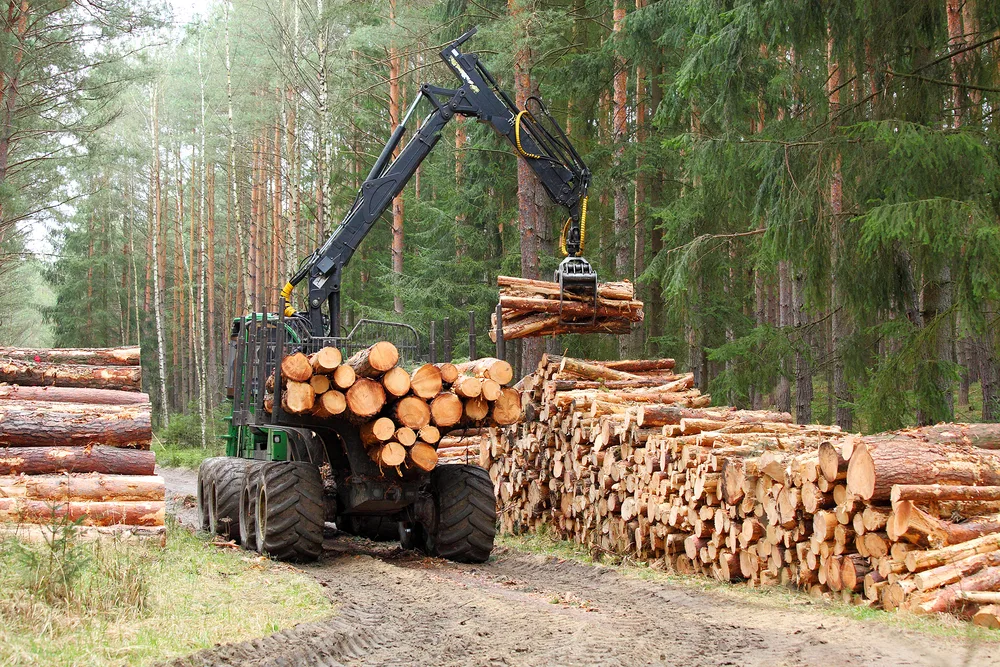A lot of investors relate well to asset classes that they have some background in. I grew up on a farm, so relating to dirt (IE development projects & farms) came naturally to me.
Most of us have lived in rental housing at some point in our lives, so many investors go to apartments as a chosen investment. If you grew up around auto shops, manufacturing and machining, investing in Industrial would likely come naturally.
For some investors, timberland as an asset they can relate with also comes naturally. Over the years, I have had a handful of clients who almost knew nothing about traditional real estate investments, but knew that they could make money with forested lands.
1. Timberland Is a Real Asset That Grows in Value – Literally
Unlike traditional real estate, where value is often driven by market demand and rents, timberland produces a renewable and physical product: trees. As trees grow, they increase in both volume and value, compounding your investment over time. This biological growth means that, even in years when you don’t harvest, the trees themselves are getting larger and more valuable.
- What makes timber particularly attractive is that harvesting can be timed strategically. If lumber prices are low, you can simply wait — the trees continue to grow, and you continue to accumulate value.
- This ability to defer income until market conditions improve gives investors flexibility that few other asset classes offer.
- In a managed timber stand, trees with the highest potential will be left to grow into high value products— a process that can take 25 to 30 years or more.
- To help the higher-quality trees reach their full potential and value, lower quality trees will be selected and removed from the stand, often around the 12 – 15 year mark, depending on your stand’s genetics. This is what’s known as a “thinning.”
2. Types of Timber & Values
Timberland can be classified as mainly:
- Hardwoods: Hardwood refers to trees with broad, flat or scalloped leaves. Most hardwoods are deciduous, meaning they drop their leaves each year.
- Softwoods: These trees tend to be evergreen, rather than dropping their leaves in cycles each year. Most softwood is produced by conifer trees — spruces, firs, and pines.
The pricing for softwood or hardwood depends on the demand for a particular product at that time in the market, which fluctuates and also varied depending on location.
Other factors influencing value:
- Location: The availability and proximity to mills is a large contributor of value. If a mill is the only one in a region, and they only need a certain type of wood product, the value for your timber will be affected. More mills in a region will provide more options for selling your product.
- Transportation Costs: The costs to transport is a major contributing factor, and how far the lumber must go to reach a mill will have a bearing on costs. Some areas like the Pacific northwest have a large market and more mills than other slower growing regions of the US.
3. Tax Treatments
For Timberland held for investment purposes, owners can benefit to similar rules regarding other real estate investments.
- Remember, land is not depreciable, but costs incurred to maintain (Property taxes, insurance, mowing, etc) timberland would be deductible.
- For timber that was held for investment purposes over 1 year, the tax treatment is for a long term capital gain at the time of a timber sale.
- A depletion/depreciation deduction can be taken on sale of timber, at the time of sale, to offset the gain from the property.
- The basis is factored by looking at the allocation of your original investment, and allocating appropriately to timber and land.
- For example: You purchased an acre for $30,000. The value of the timber on the land is $20,000, and the land value is $10,000. You sell the timber in 5 years for $30,000. The taxable amount is $30,000 – $20,000 (timber basis) = $10,000 subject to capital gain tax.
- Use this guide for further details on tax treatment: https://www.fs.usda.gov/land/taxtips.pdf
4. How to Invest in Timber
There are several ways for real estate investors to gain exposure to timber, depending on capital, expertise, and desired involvement:
A. Direct Ownership of Timberland
Investors can purchase forested land directly, often in partnership with professional forestry managers. This route offers the highest potential returns but requires the most management oversight, capital, and patience. Returns typically come from a mix of timber sales and land appreciation.
B. Timber Investment Management Organizations (TIMOs)
TIMOs are specialized firms that acquire and manage timberland on behalf of investors. They operate much like real estate investment managers, handling operations, harvest scheduling, and sales. Investors typically participate through private funds or partnerships.
C. Timber REITs (Real Estate Investment Trusts)
For those wanting liquidity and lower entry costs, Timber REITs such as Weyerhaeuser (WY), Rayonier (RYN), and PotlatchDeltic (PCH) trade publicly and provide exposure to timberland performance. REITs must distribute most of their income as dividends, offering regular payouts alongside potential capital appreciation.
5. Understanding Returns and Risks
Over the past few decades, U.S. timberland has produced average annual returns between 6% and 9%, with lower volatility than stocks. Returns are typically composed of three elements:
- Biological growth (tree growth) – predictable and steady
- Timber price changes – cyclical but driven by housing demand and supply constraints
- Land appreciation – varies by location and long-term development potential
That said, investors should be aware of certain risks:
- Liquidity: Selling timberland can take months or years.
- Market cycles: Lumber prices fluctuate with housing and construction trends.
- Natural risks: Fire, disease, and storms can impact growth or harvest schedules.
- Regulatory factors: Environmental regulations may affect harvest rights or land use.
Proper diversification across regions and tree species, along with insurance and professional management, can mitigate many of these risks.
6. Growing Opportunity: Carbon Credits and Mass Timber
Carbon Credits:
One of the most interesting trends in timber investing is the rise of carbon credit markets. As corporations seek to offset carbon emissions, managed forests are being recognized for their ability to capture and store carbon.
Landowners can earn income by selling carbon credits — essentially getting paid for keeping trees in the ground rather than harvesting them. For investors, this creates a new, environmentally aligned revenue stream that complements traditional timber sales.
Mass Timber:
A growing trend in commercial building construction is Mass Timber- which is building products that replace traditional steel and concrete components of a building with wood products that have been manufactured through a process of glueing together under pressure layers of wood to arrive at a product that rivals steel with strength and endurance.
The benefit to Mass Timber is the environmentally friendly component of renewable wood products, that also capture carbon while growing.
The End, or the beginning of something new
For real estate investors, timberland offers a different dynamic that provides income, passive growth and a renewable world benefit.
It’s an asset that literally grows while you wait, provides flexible income options, and serves as a hedge against inflation and volatility.
In a world where many investments rely on short-term trends or paper assets, timber stands tall — quite literally — as a sustainable, time-tested way to build wealth for generations.
In a world that is rapidly changing, it is good to know that some time tested resources remain consistent. Many of our clients appreciate the balance of new creative thinking and long term tried and true basics. Reach out to us for a strategy discussion if you are looking to grow your real estate investments for the long term. While we are not timber experts, we can provide feedback based on our experience and provide insight on general investment returns.
Sources
https://timberupdate.com/timber-services
https://timberupdate.com/timber-prices
https://smartasset.com/investing/timber-investment
https://www.fs.usda.gov/land/taxtips.pdf
https://terrapass.com/blog/creating-carbon-credits-is-it-profitable/





